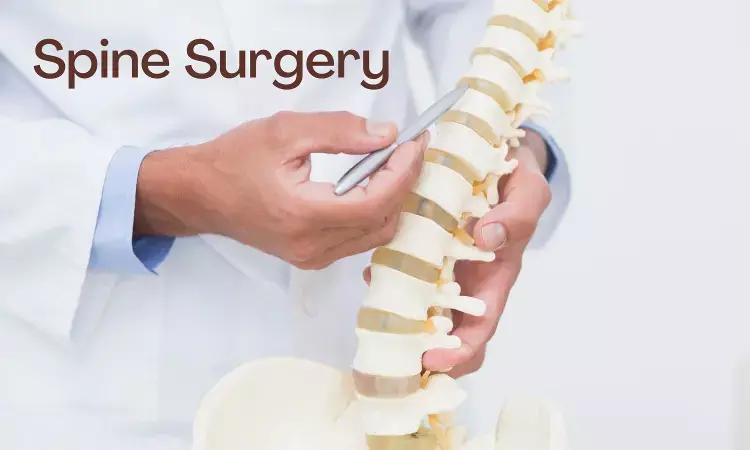- Home
- Medical news & Guidelines
- Anesthesiology
- Cardiology and CTVS
- Critical Care
- Dentistry
- Dermatology
- Diabetes and Endocrinology
- ENT
- Gastroenterology
- Medicine
- Nephrology
- Neurology
- Obstretics-Gynaecology
- Oncology
- Ophthalmology
- Orthopaedics
- Pediatrics-Neonatology
- Psychiatry
- Pulmonology
- Radiology
- Surgery
- Urology
- Laboratory Medicine
- Diet
- Nursing
- Paramedical
- Physiotherapy
- Health news
- Fact Check
- Bone Health Fact Check
- Brain Health Fact Check
- Cancer Related Fact Check
- Child Care Fact Check
- Dental and oral health fact check
- Diabetes and metabolic health fact check
- Diet and Nutrition Fact Check
- Eye and ENT Care Fact Check
- Fitness fact check
- Gut health fact check
- Heart health fact check
- Kidney health fact check
- Medical education fact check
- Men's health fact check
- Respiratory fact check
- Skin and hair care fact check
- Vaccine and Immunization fact check
- Women's health fact check
- AYUSH
- State News
- Andaman and Nicobar Islands
- Andhra Pradesh
- Arunachal Pradesh
- Assam
- Bihar
- Chandigarh
- Chattisgarh
- Dadra and Nagar Haveli
- Daman and Diu
- Delhi
- Goa
- Gujarat
- Haryana
- Himachal Pradesh
- Jammu & Kashmir
- Jharkhand
- Karnataka
- Kerala
- Ladakh
- Lakshadweep
- Madhya Pradesh
- Maharashtra
- Manipur
- Meghalaya
- Mizoram
- Nagaland
- Odisha
- Puducherry
- Punjab
- Rajasthan
- Sikkim
- Tamil Nadu
- Telangana
- Tripura
- Uttar Pradesh
- Uttrakhand
- West Bengal
- Medical Education
- Industry
Intraoperative neuromonitoring important tool for monitoring neurologic function during ASD surgery: Study

Study Design: Systematic review.
Intraoperative neuromonitoring (IOMN) has become a standard practice in the detection and prevention of nerve damage and postoperative deficit. While multicenter studies have addressed this inquiry, there have been no systematic reviews to date. Chloe Cottone et al published a study in ‘global spinal journal.’ This systematic review identifies the leading causes of IONM alerts during adult spinal deformity (ASD) surgeries.
Following PRISMA guidelines, a literature search was performed in PubMed and Embase. IONM alert causes were grouped by equivalent terms used across different studies and binned into larger categories, including surgical maneuver, Changes in blood pressure/temperature, Oxygenation, Anesthesia, Patient position, and Unknown. Inclusion criteria were studies on adult patients receiving ASD correction surgery using IONM with documented alert causes.
Key findings of the study were:
• 1544 references were included in abstract review, 128 in full text review, and 16 studies (8 retrospective reviews, 4 prospective cohort studies, and 4 case series) qualified for data extraction.
• There were a total of 3945 adult patients with 299 IONM alerts.
• Surgical maneuver led the alert causes (258 alerts/86.3%), with signal loss most commonly occurring at correction or osteotomy (101/33.8% and 95/31.8% respectively).
• Pedicle screw placement caused 35 alerts (11.7%).
• Changes in temperature and blood pressure were the third largest category (34/11.4%).
• Unknown cause (1%), patient positioning (.7%), oxygenation (.3%), and anesthesia (.3%).
The authors concluded that – “IONM is an important tool for monitoring neurologic function during ASD surgery and preventing long-term neurologic injury. The purpose of this systematic review was to evaluate and quantify the most common causes of IONM alerts during ASD surgery. Our data shows the majority of IONM alerts are related to surgical maneuvers. Correction, osteotomies, and pedicle screw placement were all significant sources of alerts. A minority of alerts were related to changes in body temperature or blood pressure. These aforementioned causes were responsible for nearly 98% of all alerts, with repositioning, ischemic shock, and unknown or other reasons accounting for the remainder. In conclusion, it is important that surgeons are aware of the described and predictable causes of IONM alerts, as they introduce significant risk of long-term neurologic injury if they are not reversed in a timely manner.”
Further reading:
Causes of Intraoperative Neuromonitoring Events in Adult Spine Deformity Surgery: A Systematic Review Chloe Cottone et al Global Spine Journal 2024 DOI: 10.1177/21925682241242693
MBBS, Dip. Ortho, DNB ortho, MNAMS
Dr Supreeth D R (MBBS, Dip. Ortho, DNB ortho, MNAMS) is a practicing orthopedician with interest in medical research and publishing articles. He completed MBBS from mysore medical college, dip ortho from Trivandrum medical college and sec. DNB from Manipal Hospital, Bengaluru. He has expirence of 7years in the field of orthopedics. He has presented scientific papers & posters in various state, national and international conferences. His interest in writing articles lead the way to join medical dialogues. He can be contacted at editorial@medicaldialogues.in.


